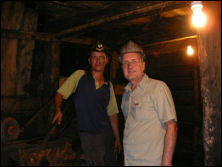Muzo Mine - Emeralds In Columbia
One of the worlds largest known deposits of emeralds is found at the Muzo mine, which is located in the western foothills of the eastern branch of the Colombian Andes and are distant about 96 km. (60 miles ą) in a direct north-westerly line from Bogotá, the capital of Colombia .
Spaniards acquired their first indication of the source of the emerald in 1537, when Gonzalo Jimenez de Quesada, the conqueror of interior Colombia and the founder (in 1538) of the city of Bogotá, entered the valley of Guachetá in the Chibcha domain and received nine emeralds as a gift from the Indians. . It took 20 years for the Conquistadors to try and force the subjugated Incas to reveal the location of the hidden tunnels of which even the paths had been overgrown by the jungle. Finally the Spanish (lead by Luiz Lanchero), almost by accident, found them on their own and began mining and producing for the Spanish crown, who claimed one-fifth, and for a time actively prosecuted in the face of repeated attacks by the Indians. The locality, however, was subsequently abandoned and the mine became overgrown with jungle, and its position has not since been discovered. The rarity of emeralds has been evidenced by the struggle to find them, which has been the main factor in its high value over the centuries.
Ineffective mining continued to the middle of the 18th Century or thereabouts, when a disastrous fire terminated activities for a time. Work was later resumed but prosecuted only in a desultory fashion until the success of the War of Independence in 1819 transferred the holdings to the new-born Republic. The republican Government at the outset lacked the organization necessary for running the mines, but realizing their possibilities as a source of revenue, soon contracted for their private exploitation, the terms being 10 per cent. of the net profits. The mines were worked under lease from 1824 to 1848,when Congress in Bogotá decreed that all emerald deposits found in the country should be worked under the direction of the nation. This decree does not seem to have been strictly adhered to, for contracts with private parties were subsequently entered into by the Government, some being in the nature of partnerships, others being strict concessions. Operations have been totally suspended, however, since Jan. 1, 1913, owing to the fact that the appropriations for administration and exploitation, being entirely insufficient for re-establishing mining activity, were applied merely to the maintenance of the property. The European War, in its effect on the precious stone market, precludes profitable exploitation in the immediate future.
Five unnamed large emerald crystals from Muzo are located in the vault of the Bank of the Republic of Colombia and they weigh between 1,100 carats to 1,796 carats, as well as one weighing 220 carats. The Crown of the Andes is probably the most famous single piece of emerald jewellery with 453 stones (1,521 cts.) including the Atahualpa Emerald (45 cts.) named after one of the last Inca emperors. The Crown, Fashioned from a solid block of pure gold, was made in 1593 for the Madonna statue in Popayan, Colombia. Briefly captured by English pirates in 1650 it was recovered and became a prize of revolutionary war for independence from Spain waged by Simon Bolivar in 1812. Its present location is unknown.

